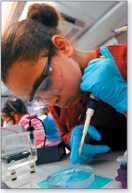Science Safety Rules
Working in the laboratory can be an exciting experience, but it can also be dangerous if proper safety rules are not followed at all times. To prepare yourself for a safe year in the laboratory, read the following safety rules. Make sure that you understand each rule. Ask your teacher to explain any rules you don't understand.
Dress Code
Many materials in the laboratory can cause eye injury. To protect yourself from possible injury, wear safety goggles whenever you are working with chemicals, burners, or any substance that might get into your eyes. Avoid wearing contact lenses in the laboratory. Tell your teacher if you need to wear contact lenses to see clearly, and ask if there are any safety precautions you should observe.
Wear a laboratory apron or coat whenever you are working with chemicals or heated substances.
Tie back long hair to keep it away from any chemicals, burners, candles, or other laboratory equipment.
Before working in the laboratory, remove or tie back any article of clothing or jewelry that can hang down and touch chemicals and flames.

General Safety Rules and First Aid
Read all directions for an experiment several times. Follow the directions exactly as they are written. If you are in doubt about any part of the experiment, ask your teacher for assistance.
Never perform investigations your teacher has not authorized. Do not use any equipment unless your teacher is in the lab.
Never handle equipment unless you have specific permission.
Take care not to spill any material in the laboratory. If spills occur, ask your teacher immediately about the proper cleanup procedure. Never pour chemicals or other substances into the sink or trash container.
Never eat or drink in, or bring food into, the laboratory.
Immediately report all accidents, no matter how minor, to your teacher.
Learn what to do in case of specific accidents, such as getting acid in your eyes or on your skin. (Rinse acids off your body with lots of water.)
Be aware of the location of the first-aid kit. Your teacher should administer any required first aid due to injury. Your teacher may send you to the school nurse or call a physician.
Know where and how to report an accident or fire. Find out the location of the fire extinguisher, fire alarm, and phone. Report any fires to your teacher at once.
Heating and Fire Safety
Never use a heat source such as a candle or burner without wearing safety goggles.
Never heat a chemical you are not instructed to heat. A chemical that is harmless when cool can be dangerous when heated.
Maintain a clean work area and keep all materials away from flames. Be sure that there are no open containers of flammable liquids in the laboratory when flames are being used.
Never reach across a flame.
Table of Contents
- Formulas and Equations
- Applying Formulas and Equations
- Mean, Median, and Mode
- Estimation
- Using Measurements in Calculations
- Effects of Measurement Errors
- Accuracy
- Precision
- Comparing Accuracy and Precision
- Significant Figures
- Calculating With Significant Figures
- Scientific Notation
- Calculating With Scientific Notation
- Dimensional Analysis
- Applying Dimensional Analysis




